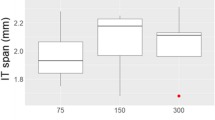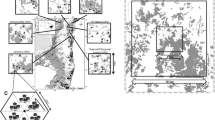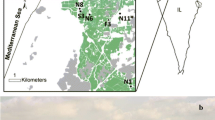Abstract
Context
In modern agricultural landscapes, fragmentation of partial habitats is a significant filter for multi-habitat users, reducing local taxonomic and functional diversity. There is compelling evidence that small species are more susceptible than large species. The impact of habitat fragmentation on intraspecific body-size distribution, however, is yet unexplored.
Objectives
We tested habitat fragmentation, a major driver of pollinator loss, for its impact on intraspecific body-size distributions of solitary wild-bee species. Subsequently, we tested individual body size for its impact on pollination services.
Methods
We sampled 1272 individuals of the four most common Andrena wild bee species in 22 newly established flowering fields (0.21–0.41 ha) in Hessen, Central Germany, over two consecutive years. Study sites were located in a ca. 80 ha landscape context of increasing habitat fragmentation. We analysed the pollen loads of the most abundant species.
Results
Body size within local populations of the two medium-sized bees increased with fragmentation, suggesting intraspecific selection for higher dispersal capacity. Pollen analysis carried out for the most common species revealed that larger individuals visited a significantly smaller plant spectrum. Habitat fragmentation may thus alter pollination services without necessarily affecting species richness or composition.
Conclusions
Systematic body-size variation at the population level thus explains the considerable variability between simple community measures and ecosystem functioning. Filtering processes at the individual level require increased understanding for targeting pollination services under current and future land-use change.


Similar content being viewed by others
References
Areco-Gómez G, Ashman T (2014) Heterospecific pollen receipt affects self pollen more than outcross pollen: implications for mixed-mating plants. Ecology 95:2946–2952
Berggren A (2005) Effect of propagule size and landscape structure on morphological differentiation and asymmetry in experimentally introduced Roesel’s bush-crickets. Conserv Biol 19:1095–1102
Beattie AJ (1971) A technique for the study of insect-borne pollen. Pan-Pac Entomol 47:82
Beug H-J (2004) Leitfaden der Pollenbestimmung für Mitteleuropa und angrenzende Gebiete. Verlag Dr. Friedrich Pfeil, München
Bollen K, Jackman R (1990) Regression diagnostics: an expository treatment of outliers and influential cases. In: Fox J, Long J (eds) Modern methods of data analysis. Sage Publications, Beverly Hills, pp 257–291
Bommarco R, Biesmeijer JC, Meyer B, Potts SG, Pöyry J, Roberts SP, Steffan-Dewenter I, Öckinger E (2010) Dispersal capacity and diet breadth modify the response of wild bees to habitat loss. Proc Roy Soc B-Biol Sci 277:2075–2082
Chown SL, Gaston KJ (2010) Body size variation in insects: a macroecological perspective. Biol Rev 85:139–169
Clough Y, Ekroos J, Báldi A, Batáry P, Bommarco R, Gross N, Holzschuh A, Hopfenmüller S, Knop E, Kuussaari M, Lindborg R (2014) Density of insect-pollinated grassland plants decreases with increasing surrounding land-use intensity. Ecol Lett 17:1168–1177
Fontaine C, Collin CL, Dajoz I (2008) Generalist foraging of pollinators: diet expansion at high density. J Ecol 96:1002–1010
Franzen M, Larsson M, Nilsson S (2009) Small local population sizes and high habitat patch fidelity in a specialised solitary bee. J Insect Conserv 13:89–95
Franzen M, Nilsson SG (2013) High population variability and source-sink dynamics in a solitary bee species. Ecology 94:1400–1408
Fründ J, Dormann CF, Holzschuh A, Tscharntke T (2013) Bee diversity effects on pollination depend on functional complementarity and niche shifts. Ecology 94:2042–2054
Génissel A, Aupinel P, Bressac C, Tasei JN, Chevrier C (2002) Influence of pollen origin on performance of Bombus terrestris micro-colonies. Entomol Exp Appl 104:329–336
Greenleaf SS, Williams NM, Winfree R, Kremen C (2007) Bee foraging ranges and their relationship to body size. Oecologia 153:589–596
Hanski I, Erälahti C, Kankare M, Ovaskainen O, Sirén H (2004) Variation in migration propensity among individuals maintained by landscape structure. Ecol Lett 7:958–966
Hill JK, Thomas CD, Blakeley DS (1999) Evolution of flight morphology in a butterfly that has recently expanded its geographic range. Oecologia 121:165–170
Jauker B, Krauss J, Jauker F, Steffan-Dewenter I (2013) Linking life history traits to pollinator loss in fragmented calcareous grasslands. Landscape Ecol 28:107–120
Kremen C (2005) Managing ecosystem services: what do we need to know about their ecology? Ecol Lett 8:468–479
Kleijn D, van Langevelde F (2006) Interacting effects of landscape context and habitat quality on flower visiting insects in agricultural landscapes. Basic Appl Ecol 7:201–214
Klein AM, Vaissiere BE, Cane JH, Steffan-Dewenter I, Cunningham SA, Kremen C, Tscharntke T (2007) Importance of pollinators in changing landscapes for world crops. Proc Roy Soc B-Biol Sci 274(1608):303–313
Kunin WE (1993) Sex and the single mustard: population density and pollinator behavior effects on seed-set. Ecology 74:2145–2160
Levy RA, Nufio CR (2015) Dispersal potential impacts size clines of grasshoppers across an elevation gradient. Oikos 124:610–619
MacArthur RH, Diamond JM, Karr JR (1972) Density compensation in island faunas. Ecology 53:330–342
Michener CD (2007) The bees of the world, 2nd edn. Johns Hopkins University Press, Baltimore
Peat J, Darvill B, Ellis J, Goulson D (2005) Effects of climate on intra- and interspecific size variation in bumble-bees. Funct Ecol 19:145–151
Radmacher S, Strohm E (2010) Factors affecting offspring body size in the solitary bee Osmia bicornis (Hymenoptera, Megachilidae). Apidologie 41:169–177
Schweiger O, Maelfait JP, van Wingerden W, Hendrickx F, Billeter R, Speelmans M, Augenstein I, Aukema B, Aviron S, Bailey D, Bukacek R (2005) Quantifying the impact of environmental factors on arthropod communities in agricultural landscapes across organizational levels and spatial scales. J Appl Ecol 42:1129–1139
Steffan-Dewenter I, Münzenberg U, Bürger C, Thies C, Tscharntke T (2002) Scale-dependent effects of landscape context on three pollinator guilds. Ecology 83:1421–1432
Steffan-Dewenter I, Tscharntke T (1999) Effects of habitat isolation on pollinator communities and seed set. Oecologia 121:432–440
Stout JC (2000) Does size matter? Bumblebee behaviour and the pollination of Cytisus scoparius L. (Fabaceae). Apidologie 31:129–139
Taylor PD, Merriam G (1995) Wing morphology of a forest damselfly is related to landscape structure. Oikos 73:43–48
Tepedino VJ, Sipes SD, Griswold TL (1999) The reproductive biology and effective pollinators of the endangered beardtongue Penstemon penlandii (Scrophulariaceae). Plant Syst Evol 219:39–54
Vivarelli D, Petanidou T, Nielsen A, Cristofolini G (2011) Small-size bees reduce male fitness of the flowers of Ononis masquillierii (Fabaceae), a rare endemic plant in the northern Apennines. Bot J Linn Soc 165:267–277
Westrich P (1989) Die Wildbienen Baden-Württembergs. Eugen Ulmer, Stuttgart
Williams NM, Crone EE, Roulston TH, Minckley RL, Packer L, Potts SG (2010) Ecological and life-history traits predict bee species responses to environmental disturbances. Biol Conserv 143:2280–2291
Willmer PG, Finlayson K (2014) Big bees do a better job: intraspecific size variation influences pollination effectiveness. J Poll Ecol 14:244–254
Winfree R, Aguilar R, Vázquez DP, LeBuhn G, Aizen MA (2009) A meta-analysis of bees’ responses to anthropogenic disturbance. Ecology 90:2068–2076
Zurbuchen A, Cheesman S, Klaiber J, Müller A, Hein S, Dorn S (2010) Long foraging distances impose high costs on offspring production in solitary bees. J Anim Ecol 79:674–681
Acknowledgments
DW was funded by Deutsche Bundesstiftung Umwelt (DBU). We thank M. Zerbe and K. Weiss of Amt für Ländlichen Raum Landkreis Marburg Biedenkopf for cooperation in site selection and farmers for access to their land. The Hessisches Ministerium für Energie, Landwirtschaft und Verbraucherschutz (HMUELV) and the Hessisches Landesamt für Umwelt und Geologie (HLUG) kindly provided digital land-use maps. We thank Stefanie Ettling for supporting pollen analysis and two anonymous reviewers for helpful comments.
Author information
Authors and Affiliations
Corresponding author
Electronic supplementary material
Below is the link to the electronic supplementary material.
Rights and permissions
About this article
Cite this article
Warzecha, D., Diekötter, T., Wolters, V. et al. Intraspecific body size increases with habitat fragmentation in wild bee pollinators. Landscape Ecol 31, 1449–1455 (2016). https://doi.org/10.1007/s10980-016-0349-y
Received:
Accepted:
Published:
Issue Date:
DOI: https://doi.org/10.1007/s10980-016-0349-y




